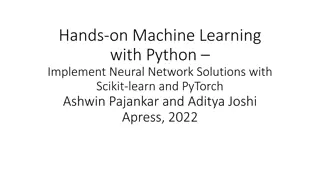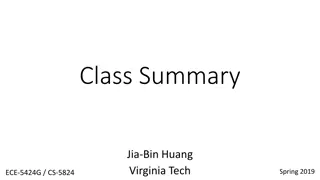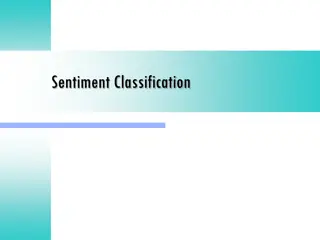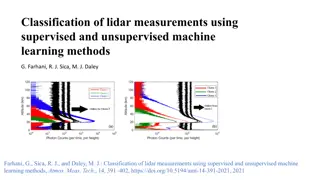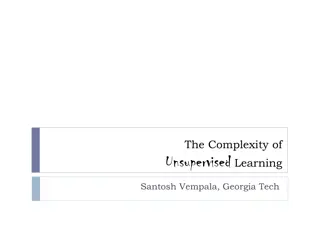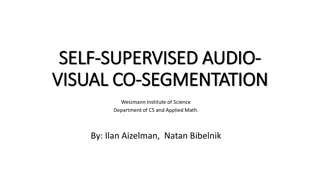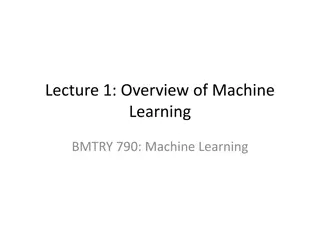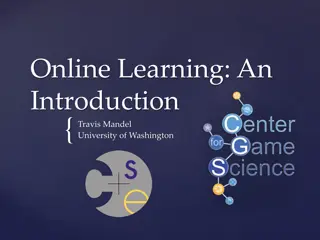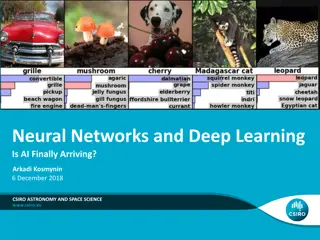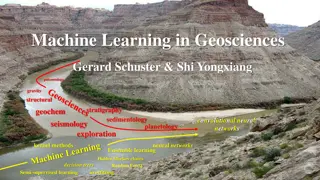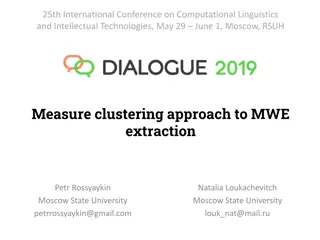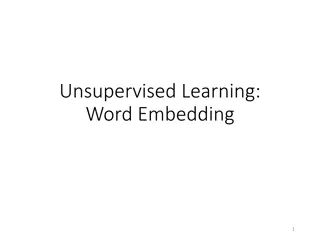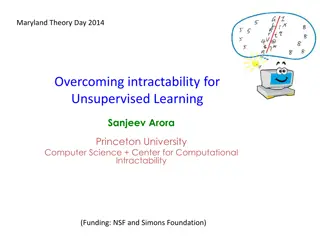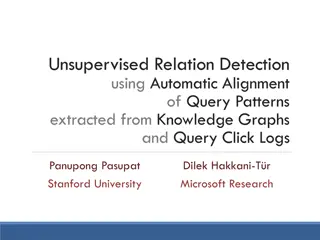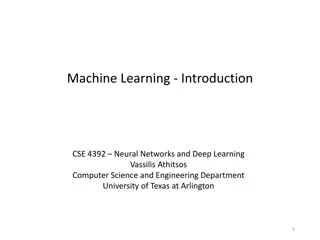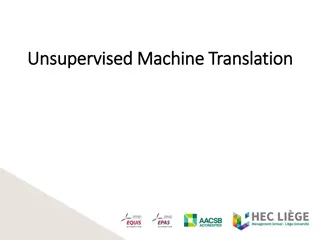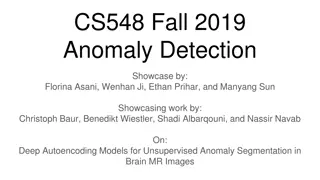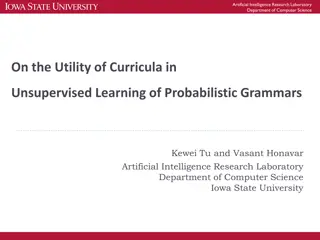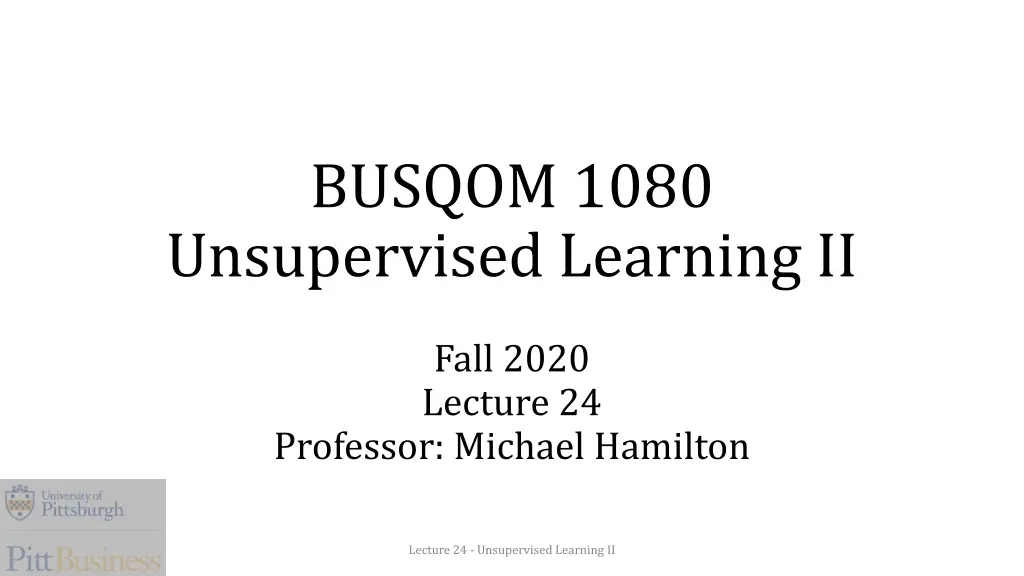
Unsupervised Learning II - Clustering Algorithms and K-Means Implementation
"Explore advanced unsupervised learning techniques in Lecture 24, focusing on clustering methods such as K-Means algorithm. Understand the concepts behind clustering, pros and cons of K-Means, and different types of clustering algorithms."
Uploaded on | 0 Views
Download Presentation

Please find below an Image/Link to download the presentation.
The content on the website is provided AS IS for your information and personal use only. It may not be sold, licensed, or shared on other websites without obtaining consent from the author. If you encounter any issues during the download, it is possible that the publisher has removed the file from their server.
You are allowed to download the files provided on this website for personal or commercial use, subject to the condition that they are used lawfully. All files are the property of their respective owners.
The content on the website is provided AS IS for your information and personal use only. It may not be sold, licensed, or shared on other websites without obtaining consent from the author.
E N D
Presentation Transcript
BUSQOM 1080 Unsupervised Learning II Fall 2020 Lecture 24 Professor: Michael Hamilton Lecture 24 - Unsupervised Learning II
Lecture Summary Today: More on Unsupervised Learning 1. Recap K Means[10 Mins] 2. Hierarchical approach [20 Mins] Lecture 24 - Unsupervised Learning II
Data for lecture Cereal dataset Average review data for 43 breakfast cereals in Europe cereal = read.table("BreakfastCereals.txt", sep = "\t", header = T) Lecture 24 - Unsupervised Learning II
Recap: Unsupervised Learning Unsupervised Learning: There are no dependent variables, no class labels. Data: N observations each with p features X1, X2 , XN Goal: Not interested in prediction, instead we want to discover interesting patterns or subgroups in the data. Lecture 24 - Unsupervised Learning II
Clustering (Introduction) Input Input: A set of N points ? ? R2(Rp ) and a positive integer k Objective Objective: Assign each point to a cluster C1, C2, , Ck Lecture 24 - Unsupervised Learning II
K Means (Lloyds) Algorithm Simple local search heuristic to find good centers Lloyds Algorithm 0. Initialization: Randomly assign each point to a cluster Ci 1. For each cluster Ci, compute the center ci = 2. Reassign each point to the nearest center 3. Repeat until centers converge (that is, repeat until labels of points stop changing). 1 |??| ??? ???? Lecture 24 - Unsupervised Learning II
K Means Algorithm Pros: Easy to describe and implement Usually converges quickly Cons: No guarantee of solution quality No guarantee of fast convergence Bad initializations lead to bad answers Only finds convex clusters Need to specify k Lecture 24 - Unsupervised Learning II
Two Types of Clustering Algorithms Nonhierarchical Methods 1. Clusters are initially formed based on specified numbers. 2. Assigns records to each cluster. 3. Simple and computationally less expensive, so it is the preferred method for very large data sets. Hierarchical Methods 1. Agglomerative algorithm begins with N clusters and starts merging sequentially with similar clusters until a single cluster is formed. 2. Divisive algorithm first starts with one single cluster and then divides into multiple clusters based on dissimilarities. Lecture 24 - Unsupervised Learning II
Hierarchical Clustering Methods Agglomerative hierarchical methods: 1. Start with individual objects (as many clusters as objects) 2. Group most similar objects first 3. As similarity decreases, all subgroups are merged to form single cluster Divisive hierarchical methods: 1. Start with two subgroups (dissimilar) 2. Divide subgroups further into dissimilar subgroups 3. Eventually, each object forms its own group Display results in a dendrogram to illustrate mergers or divisions Lecture 24 - Unsupervised Learning II
Dendrogram - A way of describing hierarchical clustering Clustering of size 2 Clustering of size 3 Clustering of size 4 Clustering of size 6 Start Start: Each point is in its own cluster Lecture 24 - Unsupervised Learning II
Linkage Methods 1. Single Linkage distance between 2 clusters defined as the minimum distance between one point from each cluster (nearest neighbor approach) 2. Complete Linkage distance between 2 clusters defined as the maximum distance between one point from each cluster (farthest neighbor approach) 3. Average Linkage distance between 2 clusters defined as the average of the distances between each point in one cluster to every point in the other cluster 4. Centroid Linkage distance between 2 clusters defined as the distance between cluster centroids (average) Lecture 24 - Unsupervised Learning II
Single Linkage Single Linkage distance between 2 clusters defined as the minimum distance between one point from each cluster (nearest neighbor approach) Lecture 24 - Unsupervised Learning II
Single Linkage Start with hypothetical distances between pairs of 5 objects Lecture 24 - Unsupervised Learning II
Complete Linkage Complete Linkage distance between 2 clusters defined as the maximum distance between one point from each cluster (farthest neighbor approach) Lecture 24 - Unsupervised Learning II
Complete Linkage Lecture 24 - Unsupervised Learning II
Average Linkage Average Linkage distance between 2 clusters defined as the average of the distances between each point in one cluster to every point in the other cluster Lecture 24 - Unsupervised Learning II
Average Linkage First find most similar objects to form first cluster (UV) Distances between (UV) and the other cluster W are determined by Lecture 24 - Unsupervised Learning II
Example: Breakfast Cereals Consider nutritional information for 43 cereals Can we group cereals based on similar nutritional info? Step 1: Compute distances between individual observations Use dist() function Input variables you want to use for clustering as a matrix Specify method for computing distance Lecture 24 - Unsupervised Learning II
Example: Single Linkage Use hclust() function to obtain cluster solutions Specify single linkage method Use members argument to provide labels for observations Input distance matrix Plot result to view dendrogram Lecture 24 - Unsupervised Learning II
We can make the plot look nicer Allow labels to hang below 0 on y- axis Use labels instead of row numbers Clustering result Lecture 24 - Unsupervised Learning II
How many clusters should we choose? install.packages("NbClust") library(NbClust) Data to be clustered Distance method Specify min and max numbers of clusters to consider Clustering method Lecture 24 - Unsupervised Learning II
5 Clusters suggested Lecture 24 - Unsupervised Learning II
Plots from NbClust() Lecture 24 - Unsupervised Learning II
Lets visualize 5 clusters on dendogram Use rect.hclust() function Previous plot Number of clusters Clustering result Lecture 24 - Unsupervised Learning II
Potential Problem: Scaling Differences in scales of variables means some variables carry more weight i.e. closeness in one variable is more important than another Easy to fix though, just by standardizing the data first Lecture 24 - Unsupervised Learning II
Clustering with Standardized Data Lecture 24 - Unsupervised Learning II
Final Clusters Use cutree() function: Clustering resultNumber of clusters Aggregate data based on final clusters Lecture 24 - Unsupervised Learning II
How do other hierarchical methods compare? Complete Linkage: 4 clusters Same number but different clusters than single linkage Average Linkage: 6 clusters Largest cluster from single linkage split into 3 groups Centroid Linkage: 4 clusters In this case, same result as single linkage (not always) Lecture 24 - Unsupervised Learning II

